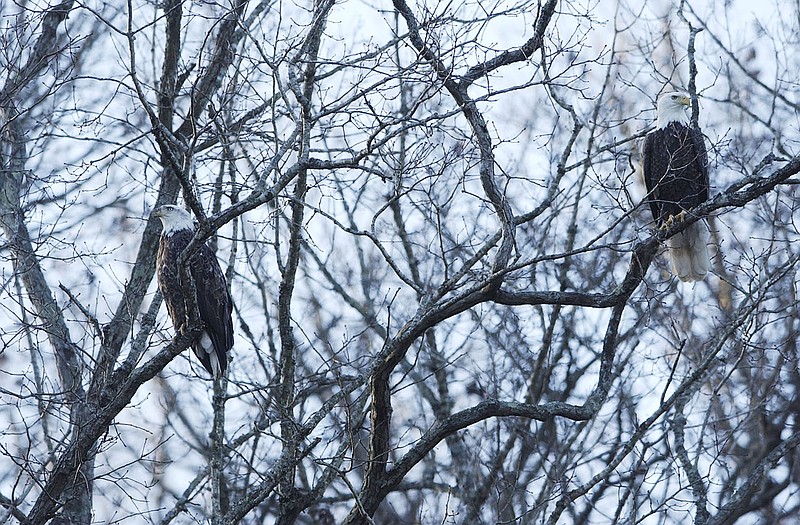Bald eagles are welcome wintertime guests as they migrate south to Beaver Lake and the region's smaller waterways.
The number of bald eagles that call Beaver their winter home peaks in January. Chances are excellent a cruise on the lake will reveal a sighting or two, maybe even a dozen or more bald eagles. Army Corps of Engineers rangers count bald eagles on the lake most Januaries, and the effort turns up around 100 to 200 eagles.
Pontoon-boat, eagle-viewing tours at the lake offered by Hobbs State Park-Conservation Area won't be held this winter. Even without these organized tours, it's easy to set out in your own boat to see bald eagles soaring overhead or resting in shoreline trees.
Two hot spots for spotting eagles are the Indian Creek arm of the lake, west of Beaver Dam, and the Van Winkle Hollow arm east of Rocky Branch park.
Most winters, the Indian Creek arm holds high numbers of eagles. Most are in the back of the arm that's wooded and isolated. There's no guarantee, but eagles usually flock to this area of the reservoir.
The Van Winkle Hollow arm of Beaver Lake is where Hobbs State Park-Conservation Area takes folks to see bald eagles aboard their 20-passenger pontoon boat. The back half of this 3-mile-long creek arm is wooded and remote as well. It's a haven for bald eagles.
Eagles like to be where people aren't. That's why the backs of these creek arms usually hold good concentrations of them. Other creek arms worth investigating include Joe's Creek near Horseshoe Bend park, Ventris Hollow east of Prairie Creek park and Ford's Creek west of Rocky Branch park.
For kayak and canoe paddlers, Van Winkle Hollow is the best bet. There are two good spots to launch paddlecraft. One is at the very back of the hollow. To get there, drive to the junction of Arkansas 303 and Arkansas 12, in the heart of Hobbs State Park. Drive north on 303, and, in one-quarter mile, turn right on the gravel road and follow it downhill for one-half mile to the lake.
Another paddlecraft launch spot is at the end of Paige Sawmill Road at Hobbs State Park. From Arkansas 12, turn north on to Rambo Road. Go about a mile downhill to a sharp bend in the pavement at the bottom. Here Paige Sawmill Road, which is gravel, continues straight ahead. Follow it about one-quarter mile to the lake.
Be extra careful eagle-watching in a canoe or kayak. The water is deadly cold now, about 45 degrees. Stay close to shore for safety and carry a change of clothes in the event of an upset.
The first glimpse an eagle cruiser might see is the white head of an adult bald eagle that's perched in a tree. It'll look like a golf ball or a white foam coffee cup among the branches. A look through binoculars will reveal the rest of the bird.
Juvenile bald eagles are harder to spot. Bald eagles don't get their white head and tail feathers until they're five or six years old. These young eagles appear as mottled brown in color, perfect camouflage in the lakeside trees.
Eagle cruisers are bound to see more turkey vultures than bald eagles. Both look alike soaring overhead. But the wingspan of a turkey vulture is more of a V shape as it soars. Bald eagles soar on a flat wingspan.
The monkey wrench here is the black vulture. Black vultures also soar on a flat wingspan, but are smaller than a bald eagle.
Winter is when eagles are most plentiful here, but there are enough bald eagles and eagle nests now that bald eagles are seen in Northwest Arkansas even in summer. Eagles that have migrated from up north will start leaving the lake around mid-February.
If Hobbs State Park is able to resume their excellent eagle cruises this winter, we'll get the word out here in NWA Outdoors. Until then, happy eagle-watching on your own winter cruise.
Flip Putthoff can be reached at fputthoff@nwadg.com

